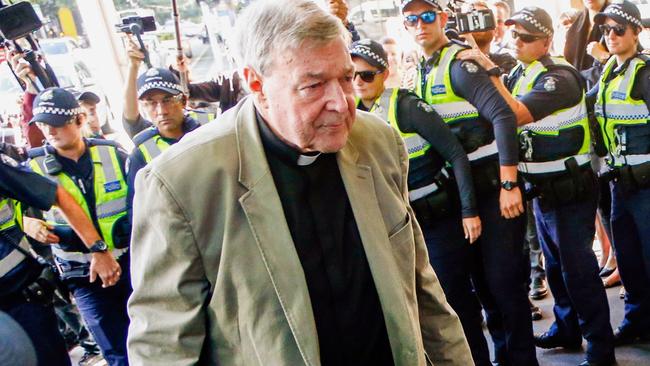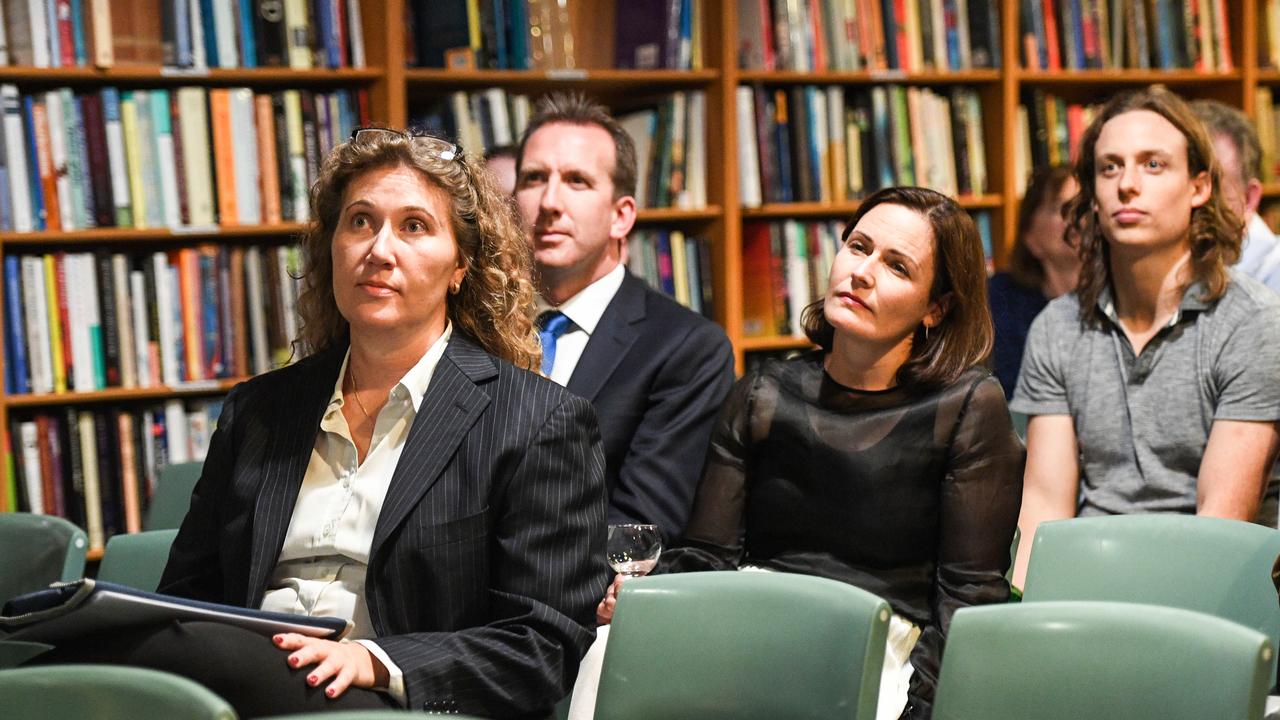Back to the courtroom for George Pell
Cardinal George Pell’s supporters are hoping for an early release from prison.

As George Pell approaches his first Christmas behind bars, he is contemplating whether to apply for bail and looking positively towards the prospects of freedom.
While Pell has very little chance of being bailed before next year’s High Court deliberations, his closest supporters are still hopeful that sense of cautious optimism will improve his health and give the cardinal something to aim for.
“He has never lost his way and he is optimistic,’’ a friend told The Weekend Australian.
If Pell fails next year to have himself acquitted of the sex abuse charges, he will face two realities.
The first will be that he serves at least three years and eight months and, second, attention will turn to what he knew and when, and whether he was involved in a wider sex abuse conspiracy.
None of these things has been explored in a forensic sense since he was charged, relying as it does on other clergy to make admissions that may lead to jail or further sentences.
One of the more peculiar and potentially crucial relationships in the troubled life of George Pell is his (former) friendship with serial pedophile priest Gerald Ridsdale.
As Pell paces his cell in Melbourne, Ridsdale is enjoying the relative comforts of country prison life in western Victoria, no doubt monitoring the latest legal developments surrounding the disgraced cardinal.
While it’s widely known the pair were friends and that the cardinal accompanied Ridsdale to his first major court hearing, to this day no one knows definitively what Pell knew about his Ballarat colleague and whether they were part of a genuine conspiracy of offending.
This week’s decision by the High Court to examine Pell’s convictions for sex abuse in Melbourne in 1996 and 1997 has the potential to lead to Pell’s early release next year.
There have certainly been a lot of people who have accused Pell of wrongdoing, but other than the cathedral charges, none has progressed through the courts.
The High Court referral comes amid a growing conversation in Melbourne at the highest levels of the courts, business and politics about whether Pell should have been convicted of the cathedral attacks.
This conversation is unquestionably being fuelled by the dissenting judgment of judge Mark Weinberg in the Victorian Court of Appeal and now the High Court’s looming consideration of the Pell convictions.
Pell will desperately be wanting the High Court to reassess the evidence in his case, his supporters convinced that he has been wronged.
Weinberg, the criminal expert of the three judges, was clear in his dissenting judgment.
“Having had regard to the whole of the evidence led at trial, and having deliberated long and hard over this matter, I find myself in the position of having a genuine doubt as to the applicant’s (Pell’s) guilt,’’ Weinberg wrote.
He added that, in accordance with the principles of the High Court, “my doubt is a doubt which the jury also ought to have’’.
The High Court is now widely seen as Pell’s last chance to escape jail before having to serve his full sentence. No one sensible will be guessing which way the High Court will go.
Pell is on track, at the bare minimum, to spend more than a year behind bars, potentially up to six years, in the unlikely event that he misbehaves while being locked up.
It is a profound injustice if he is innocent, the gravest in Australia since Lindy Chamberlain didn’t kill her daughter.
It is also quite possible that Pell will find himself in jail with Ridsdale if prison officials can find a safe way of keeping the cardinal from harm while in the general prison population.
It is by no means a competition, but I am one of what must be a very small pool of people attending court to have known both Ridsdale and Pell, serving on the altar for Ridsdale when he buried a relative in the small western Victorian town of Edenhope.
Ridsdale would sometimes come knocking at our family home for what seemed like benign priestly visits, 55km from his presbytery, across the Victoria-South Australia border.
Ridsdale apparently lost interest in our family household before he ran himself out of town as the cops loomed like a bushfire over the next hill.
There are those who believe that Pell must have known what Ridsdale was doing and why he was being shuffled around the diocese, a matter that could yet be disclosed in unreleased royal commission findings.
I have interviewed Pell twice at length and reported on his at times tumultuous period as archbishop of Melbourne and then during his transition to Sydney, when the first serious sex abuse claims emerged from Phillip Island in the early 1960s.
Pell’s closest friends swear by him.
Weinberg’s effective demolition of the case against Pell was so complete that it brought into question the credibility of the complainant, bolstered the evidence of senior Catholic figures who supported Pell’s position in court, and is being seen as an effective letter to the High Court.
Rather than dying down, the Pell story is gathering momentum as a cross-denomination coalition of senior Victorians are privately discussing their concerns about whether the cardinal’s convictions are justified. The Weekend Australian has consistently reported that the surviving complainant in the case was deemed by independent observers in court as having been credible, although Weinberg seems to have had different ideas.
Support for Pell is definitely cultural, with some Catholics concerned that it was not plausible that Pell could have offended in such an overt way, so soon after solemn mass had ended.
Personal experience is being drawn on by practising Catholics to shore up their defences of the cardinal.
It also will inevitably be informing the Vatican’s defence of him.
In a short, cautious statement, the Vatican said this week that it respected the Australian legal system.
“While reiterating its trust in the Australian justice system, the Holy See acknowledges the decision of Australia’s High Court to accept Cardinal George Pell’s request of appeal, aware that the cardinal has always maintained his innocence,’’ it said.
“At this time, the Holy See reaffirms once again its closeness to those who have suffered because of sexual abuse on the part of members of the clergy.”
The suggestion circulating in senior Catholic circles in Australia is that the Vatican is on Pell’s side.
Part of the reason for the support of Pell is that those familiar with the workings of the church know that tradition and habit mean that there was only ever an extremely narrow window of opportunity for Pell to have offended after a solemn mass.
For a period in the early 1990s, I would sit near the choir at St Patrick’s Cathedral for solemn mass when Frank Little, the then archbishop of Melbourne, officiated.
In the golden 10 minutes after the service, the area between the sanctuary and the south transept was overrun with parishioners and choirboys, and then the busloads of Japanese tourists would roll in.
While Pell’s accuser says the door to the priest’s sacristy was open, it must be said that no matter how busy the area near the church’s sanctuary was, there is not a clear line of sight where the court found the offending had occurred.
And, as the Court of Appeal noted, child sex abusers can strike at the strangest times in the strangest places.
The church’s past handling of the abuse issue has been as bewildering as it has been corrupt, with Ridsdale, for example, having been moved around the diocese, NSW and the US in the guise of treatment but ultimately to protect the church.
It’s impossible to go past the findings of the sex abuse royal commission, which detailed the extent to which evildoers in the church covered up or facilitated offending. Pell’s critics argue strongly that he was part of this conspiracy.
People interested in this subject could do worse than research the commission’s investigations into Ridsdale, who probably abused hundreds of children, and the work of the Christian Brothers in the Ballarat diocese and elsewhere.
The extent of the corruption is breathtaking.
Pell is now, inextricably, part of the church’s abuse narrative, perhaps even the defining figure.
People wanting to inform themselves should read the Court of Appeal judgments, which were split 2-1 against Pell.
It’s important to note that while Weinberg was highly sceptical of the convictions, Chief Justice Anne Ferguson and Justice Chris Maxwell formed the view that the jury was justified to have convicted the cardinal on all charges.
Weinberg was not at all convinced that the surviving complainant was a compelling witness.
Conversely, independent observers have said the choirboy presented as one of the best witnesses who had walked through the revolving front door at the County Court.
Those critical of Pell point to his failure to give evidence at either trial or in the most junior court, and him being dismissed at various times in the media as a “madman’’ and vicious predator.
For many, his relentless silence for 2½ years grates.
The last serious public defence by Pell of himself came during the royal commission, at the same time he tried to explain his support for Ridsdale.
“I had some status as an auxiliary bishop and I was asked to appear with the ambition that this would lessen the term of punishment, lessen his time in jail,” Pell said.
It’s ironic that none of the current-day church leadership has provided Pell with the same level of public comfort.


